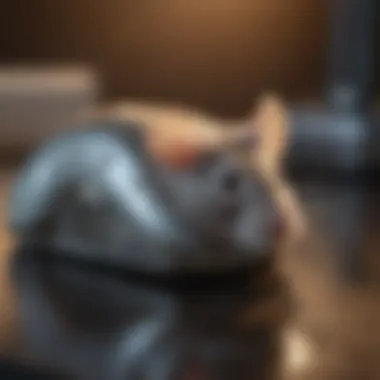Assessing Electronic Mice Repellents on Amazon


Intro
Dealing with a mouse invasion can be a trying experience for many households. The little critters, despite their cute appearance, can instigate a perfect storm of worry and discomfort. As homeowners and housewives look for solutions, the market has flooded with a variety of pest control options. Among these, electronic mice repellents have emerged as a modern remedy that is particularly interesting to explore.
The beauty of electronic repellents lies in their promise of being a humane, odorless alternative to traditional traps and poisons. But how effective are they? This article seeks to dissect the avian nature of the products available on Amazon, unveil their operational principles, and gauge user feedback.
We will also highlight eco-friendly pest management solutions—an increasingly important aspect for those keen on maintaining a sustainable home environment. In the forthcoming sections, we’ll cover key topics such as understanding your pest, preventive strategies, and available control methods.
Understanding the Pest
Identification
Before embarking on a hunt for solutions, it is essential to identify the type of pests you are dealing with. Mice are typically characterized by their small, furry bodies, large ears, and long tails. The House Mouse, a common intruder in many homes, can be particularly crafty, often venturing forth under the cover of darkness. Recognizing their droppings or gnaw marks can serve as telltale signs of an infestation.
Life Cycle
Understanding the life cycle of the house mouse can thumb your nose at future infestations. These rodents reach maturity within six weeks and can breed prolifically; a single pair can produce dozens of offspring in a year. Thus, timely intervention is crucial. They prefer warm, sheltered spaces, often forming nests in walls or behind appliances. Keeping track of their life cycle can help homeowners devise timely strategies in managing them effectively.
Pest Prevention Strategies
Environment Modification
To keep those pesky mice at bay, modifying your environment is your first line of defense. It’s often said that prevention is better than cure. Ensuring that food is stored securely, garbage is tightly sealed, and there are no open entry points can diminish the chances of attracting unwanted guests. Simple actions like keeping pantry items in airtight containers can make a world of difference.
Physical Barriers
Another effective method of safeguarding your home is utilizing physical barriers. Caulking cracks and crevices, securing vents, and even installing door sweeps can physically block entryways. Building a fortress around your fortress may sound tedious, but every little nook matters. In the language of pest control, it's akin to fortifying your home; a little effort can save you from a larger headache down the line.
Control Methods
Chemical Control
When prevention efforts fall short, it may be tempting to reach for chemical solutions. However, it pays to be cautious. Rodenticides can be effective but come with their own set of risks—especially if there are children and pets around. The adverse effects on the environment and potential poisonings can make these options less desirable for many homeowners. Therefore, information and user experiences are essential in evaluating such products.
Biological Control
Biological control methods, such as introducing natural predators, can also be a viable approach, albeit not the most practical for indoor settings. Cats, for instance, are natural hunters and can hunt down mice without the use of chemicals or devices. Additionally, understanding the ecosystem within your home can lead to a more balanced pest control scenario.
"The best mouse is a mouse that never enters your home in the first place."
As we delve deeper into the realm of electronic mice repellents in the next sections, we will explore both their promises and limitations, ensuring you make informed choices in your pest control journey.
Prologue to Electronic Mice Repellents
When it comes to maintaining a peaceful household, few nuisances are as troubling as a mouse infestation. The rustle of tiny paws, the gnawing of furry critters, or even the sight of droppings can push any homeowner’s stress levels through the roof. In response to the growing need for effective pest control solutions, electronic mice repellents have entered the market, promising an alternative to traditional methods. This section outlines the relevance of these devices, the reasons behind their increasing popularity, and what potential users should consider before integrating them into their homes.
Understanding the Need for Mice Control
Mice are not just uninvited guests; they can lead to significant health risks. These creatures are notoriously known for spreading diseases through their droppings and urine. Beyond health concerns, the structural damage they can cause by chewing through electrical wires and insulation is also alarming. Hence, controlling mice infestation is paramount for homeowners who value their family's safety and property.
Moreover, as people become more aware of the environmental impacts associated with conventional pest control methods—like toxic chemicals and traps—there is an increasing interest in alternatives that are safer for both humans and pets. Electronic mice repellents appeal to eco-conscious individuals because they offer a method that minimizes hazardous chemicals while aiming to keep these rodents at bay.
Overview of Conventional Pest Control Methods


Traditional methods of mice control often involve a heavy reliance on chemical traps and poison. While these techniques can be effective in the short term, they come with substantial drawbacks.
- Health Risks: Chemical poisons can pose significant health risks to children and pets. Accidental ingestion can lead to severe consequences.
- Ethical Concerns: Many people are uncomfortable with killing rodents, as they are living beings. This raises ethical dilemmas around the use of traditional traps and poisons.
- Cleanup Hassles: If a trap captures a mouse, the cleanup can be unpleasant and can leave a lingering, unwanted smell in the home.
In response to these concerns, electronic mice repellents offer a non-lethal option that works by emitting high-frequency sounds or electromagnetic fields, designed to deter mice without causing them harm. As these technologies evolve, they present a proactive approach to pest control that aligns better with contemporary values of conservation and humane treatment of animals.
"Mice control isn't just a necessity; it's about creating a space where you can live comfortably without fear or discomfort."
As we explore the technology behind electronic mice repellents in the next section, keep these considerations in mind. The debate surrounding efficacy, convenience, and ethics continues to shape this industry, and for many, these electronic devices may be a step toward a better pest control strategy.
The Technology Behind Electronic Mice Repellents
Understanding the mechanisms that govern electronic mice repellents is paramount for anyone looking to make informed decisions in pest management. These devices offer a contemporary solution that diverges from traditional pest control methods. They draw upon various technologies that aim to disrupt the habits of pests rather than resorting to harmful chemicals. As a homeowner or someone managing properties, recognizing how these technologies function can significantly influence your pest control strategy.
Ultrasonic Technology Explained
Ultrasonic technology is the cornerstone of many electronic mice repellents. It functions by producing high-frequency sound waves that are inaudible to humans but disruptive to rodents. This sound creates an uncomfortable auditory environment for mice, compelling them to flee the area.
- The frequency range usually lies between 20 kHz to 65 kHz, a spectrum that can irritate a mouse's sensitive hearing.
- The application of these sound waves can vary; some devices rotate frequencies to prevent mice from becoming accustomed to a fixed sound.
A common misconception is that ultrasonic repellents can be effective against all pests. While they are primarily designed for rodents, their efficacy against insects and other creatures remains debatable. Evidence has not consistently shown that these devices affect every species uniformly, leading to varied user experiences.
Electromagnetic Field Generation
In addition to ultrasonic waves, some repellents utilize electromagnetic fields. This technology works by modifying the electrical field within the walls of your home, effectively creating a barrier that mice find repulsive. The principle behind this is quite simple:
- As mice are sensitive to changes in electromagnetic fields, these fluctuations can create discomfort for them.
- Unlike ultrasonic systems, electromagnetic devices do not emit sound waves, which can make them favorable for those living in shared spaces or with pets who might be bothered by noise.
However, it’s important to note that the effectiveness of this technology can be influenced by factors like the construction materials of the building. For instance, metal walls might shield the electromagnetic fields, reducing the overall impact of these devices.
Combining Technologies for Enhanced Effectiveness
The most robust solutions in mice repelling often arise from combining both ultrasonic and electromagnetic technologies. By leveraging the strengths of each, these hybrid devices aim to maximize efficacy against mice while minimizing potential weaknesses. Here are some benefits of this combined approach:
- Broader Spectrum of Coverage: The dual approach addresses multiple behavioral patterns in pest activity. While one technology disrupts auditory senses, the other targets the discomfort from electromagnetic fields.
- Prevention of Habituation: The chances of mice becoming used to a singular frequency or field are reduced, as the varied stimuli keep them on their toes.
- Increased Consumer Confidence: Reports from users generally suggest that hybrid models tend to yield better results, fostering a sense of reliability among consumers.
In narrowing down the best choices on Amazon, examining whether a device incorporates both technologies can serve as an indicator of better performance.
The future of pest repelling lies in these innovative technologies that stress discomfort over extermination, promoting a more humane approach to pest management.
Understanding the intricacies of these technologies ultimately empowers homeowners to choose the right products for their unique situations, leading to effective pest management without resorting to harmful chemicals.
Product Comparison: Top Electronic Mice Repellents on Amazon
In the crowded marketplace of pest control solutions, electronic mice repellents have carved a niche of their own. The importance of comparing these products cannot be overstated. For homeowners looking to safeguard their living spaces, understanding the distinct features of various options can dictate the success of their pest management efforts. Comparisons allow for an informed decision based on specific needs, effectiveness, and budget. With numerous choices available on Amazon, discerning which product packs the most bang for your buck is crucial.
Product A: Features and User Feedback
When considering electronic mice repellents, Product A stands out for its innovative design and user-friendly features. This device, equipped with ultrasonic technology, claims to disrupt the auditory patterns of rodents, making the area unwelcoming for them. Many users report a noticeable difference in rodent activity after using this product. The feedback is predominantly positive, with customers praising its ease of installation and maintenance.
- Key Features:
- Ultrasonic sound wave generation.
- Coverage of up to 1500 square feet.
- Energy efficient with low power consumption.
- Portable design suitable for indoor and outdoor use.


User testimonials often echo similar sentiments: "I placed two of these devices around my home, and within days, the mice vanished. It’s like magic!" Some users, however, note a gradual timeline for effectiveness, suggesting patience and sustained use may yield the best results.
Product B: Performance Analysis
Product B, featuring dual technology that combines both ultrasonic and electromagnetic waves, has garnered significant attention. This approach aims to create a more encompassing barrier against pest invasions. Performance analysis reveals that this product functions effectively in larger areas, making it a suitable candidate for spacious homes.
- Performance Insights:
- Fast-acting within 2-3 weeks based on average user reports.
- Designed to be child and pet-friendly, a selling point for many buyers.
According to several reviews, many users remarked on the gradual decrease in sightings. "It took a few weeks, but after that, I hardly saw any signs of mice. I’m sold on it!" That said, some potential buyers express concern about its somewhat higher price point compared to competitors.
Product C: Cost-Effectiveness Review
Finally, turning to Product C, this model measures its cost against the overall effectiveness rather well. Priced competitively, it offers solid performance while staying budget-friendly, making it appealing for cost-conscious homeowners or renters.
- Financial Considerations:
- Priced under $30, often seen as a prudent investment for pest control.
- Many users report cost savings by reducing the need for traditional traps and pesticides over time.
Reviews indicate that people appreciate the balance between cost and utility. One user noted, "It’s not the fanciest model out there, but it gets the job done without breaking the bank." This reflects a tendency among users to favor practical solutions that do not compromise on effectiveness, especially for those managing tight budgets.
In summary, the analysis of these top electronic mice repellents on Amazon showcases a range of options that appeal to diverse consumer needs, from advanced technology to cost efficiency. As pest control continues to evolve, these electronic solutions represent a promising direction.
User Experiences and Reviews
Understanding user experiences with electronic mice repellents can offer invaluable insights for homeowners. These personal accounts shed light on the real-world effectiveness of the products, highlighting not just the successes but also the stumbling blocks. Homeowners are increasingly turning to these devices as an alternative to traditional pest control methods, seeking a humane and eco-friendly approach. Therefore, it’s crucial to immerse ourselves in these reports to grasp the full narrative of efficacy beyond just the marketing blurb.
Positive Outcomes Reported
Many users report that electronic mice repellents, particularly ultrasonic devices, have delivered promising results. With claims of repelling pests effectively without the use of harmful chemicals, these repellent devices have been embraced by those looking to protect their homes in a safer manner.
- User Testimonies: For instance, a woman from Indiana noted how she placed a few ultrasonic devices around her basement, and within weeks, she found no signs of mice. Another homeowner in California mentioned a significant reduction in mouse activity after implementing these repellents around her kitchen area.
- Ease of Use: Most devices are straightforward. Just plug them in, and they take it from there. Users appreciate not having to bait traps or deal with the aftermath of traditional pest control. The convenience factor is undeniably appealing, especially for busy individuals.
- Safety for Pets and Kids: Parents are particularly drawn to these products, knowing they don’t put children or pets at risk. This peace of mind has made electronic repellents a popular choice among families.
As one homeowner reflects,
"I love that I don’t have to worry about what my kids are playing with or what could end up in the trash. It's simple, and there have been zero issues since I started using them!"
This kind of feedback enriches the understanding of how electronic mice repellents can fit into everyday life, making them seem like a practical solution rather than a gamble.
Challenges and Limitations
Despite the favorable reports, some users have voiced challenges with electronic mice repellents that warrant attention. While many have seen success, it is not a one-size-fits-all solution, and some limitations have surfaced throughout various user experiences.
- Variability in Effectiveness: Certain users claim that results can be inconsistent. An individual from Texas shared how she experienced a brief success with the devices, only to then discover mice returning after a few months. This inconsistency raises questions about the longevity of effectiveness.
- Behavioral Adaptation: There are concerns that rodents might adapt to the frequencies emitted over time, leading to decreased effectiveness. Some users have pointed out that their previously successful devices seemed to lose their edge as time went on.
- Placement Sensitivity: A common challenge is the placement of devices. Some users experienced ineffective outcomes simply due to poor placement. If the devices are blocked by furniture or walls, their efficiency diminishes. One post on a pest control forum highlights this:
"I thought I was in the clear after plugging one into the living room. Turns out the couch was just blocking the signal!"
Environmental Considerations in Pest Control
As the world increasingly leans toward sustainable practices, pest control becomes a vital segment of this movement. The link between pest management and environmental health is profound; when one neglects the ecological impact of their actions, the reverberations can be felt far and wide. Understanding these environmental considerations is more than a cursory glance—it's a deep dive into how our pest control measures can align with a healthier planet.
Eco-Friendly Pest Management Practices


In recent years, the traditional methods of controlling pests, like poison traps and chemical sprays, have come under fire for their impact on both human health and wildlife. These products often walk a fine line between effectiveness and environmental safety. Eco-friendly pest management practices emphasize using solutions that minimize harm to ecosystems and human beings. Here’s how:
- Biological Control: This method involves using natural predators to regulate pest populations. For instance, ladybugs can be introduced to gardens to manage aphids without relying on pesticides. The beauty of biological control lies in its harmony with nature.
- Habitat Manipulation: Tinkering with the environment around your home can also prove effective. Keeping your yard tidy not only deters pests but also avoids providing shelter and breeding grounds for them.
- Cultural Practices: These include crop rotation and companion planting that naturally deter pests while promoting biodiversity. Not only do these methods control pests, but they also tend to enhance soil tone and fertility.
The shift from conventional methods to these environmentally conscious practices is essential. Not only does it support long-term pest management, but it also nourishes our ecosystems. With regard to electronic repellent devices, they align well with these practices as they do not utilize chemicals or biodegradable toxins, creating a more sustainable approach to pest control.
The Role of Electronic Repellents in Sustainable Solutions
Electronic mice repellents pave the way for innovative solutions without the added concern of environmental pollution. These devices often utilize ultrasonic sound waves or electromagnetic fields, designed to disrupt pests without causeing harm to non-target species. This contrasts starkly with traditional poisonous methods.
"Employing electronic repellents can drastically reduce the reliance on harmful chemicals, promoting a healthier home and environment."
Here’s how electronic repellents fit into the broader scope of sustainable pest control:
- Non-Toxic: Many of these devices are marketed as safe for children and pets, which is a significant advantage over traditional methods.
- Low Energy Consumption: Unlike other pest control strategies that may require extensive resources, electronic repellents run on low energy. This contributes to reduced carbon footprints, aligning with sustainable practices.
- Repairing Ecological Imbalances: By repelling mice without exterminating them, these devices allow for the natural population control processes to unfold, thus maintaining a balance within local ecosystems.
In the grand scheme of things, integrating electronic repellents into your pest management strategy not only serves to create an immediate solution but also addresses larger environmental goals. As we continue navigating this journey towards sustainable living, the importance of understanding these ecological impacts remains paramount.
Limitations of Electronic Mice Repellents
While electronic mice repellents offer a novel approach to pest control, understanding their limitations is crucial for homeowners seeking effective solutions. These devices, though popular on platforms like Amazon, do not universally guarantee success in deterring rodents. As with any pest management strategy, it is essential to consider these limitations to ensure effective pest control in your living space.
Factors Affecting Efficacy
Several factors can influence the efficacy of electronic mice repellents. By examining these elements, owners can make more informed decisions:
- Device Placement: The location of the repellent device plays a significant role in its effectiveness. If it's tucked away or obstructed by furniture or appliances, its ultrasonic waves may not reach their intended targets. Ideally, these devices should have an unobstructed path to cover areas where rodents are likely to pass.
- Frequency of Emissions: Different devices operate at various frequencies, which can determine how well they affect mice and other pests. Some rodents may become accustomed to the noise, leading to decreased effectiveness over time. Regularly changing the settings or positioning of these devices may be necessary to maintain their efficacy.
- Type of Rodents: Not all rodents respond the same way to electronic repellents. Certain species might be more sensitive to high-frequency sounds than others. If your issue involves multiple types of rodents, it’s possible some might escape the deterrent effect.
- Ambient Noise Levels: The surrounding environment can greatly affect how well ultrasonic waves travel. Areas with high ambient noise or other electronic devices that emit frequencies could mask the sound, thereby reducing the repellent's influence.
In essence, while electronic repellents can be a part of a pest control arsenal, their limitations need to be understood and acknowledged.
Environmental Impact Assessment
The environmental impact of electronic mice repellents is another critical aspect to consider.
- Sustainability: Many electronic pest control devices promote a more sustainable approach by reducing the need for toxic chemicals. In a world increasingly leaning towards eco-friendly practices, these devices contribute positively by minimizing hazardous wildlife impact.
- Energy Consumption: Despite their benefits, some may not realize that electronic devices require power. Energy consumption levels vary, and if the device is left on for extended periods, it could lead to higher electricity bills. Therefore, when choosing a product, it’s worthwhile to consult product specs for energy efficiency ratings.
"Electronic repellents offer a promising route for pest control but recognizing their limitations can help enhance their effectiveness and sustainability.”
- Potential Side Effects: The use of ultrasonic repellents raises questions about their effects on non-target species, including pets and wildlife. There's ongoing debate about the impact on neighborhood wildlife, which raises considerations for those living in areas with diverse ecosystems.
Culmination: The Future of Pest Control
As the battle against pests continues to evolve, understanding the best pest control methods becomes increasingly vital. Traditional approaches have their roots in tried-and-true practices, yet modern challenges and ethical considerations drive the quest for innovative solutions. The discussion surrounding electronic mice repellents isn't just about effectiveness—it's about integrating these innovations into a comprehensive strategy that meets diverse needs.
Integrating Traditional and Modern Approaches
Combining the wisdom of traditional pest control with the advancements of modern technology creates a more rounded approach. Homeowners and professionals alike often find that merely relying on one method can fall short. For example, while snap traps or poisons might yield results, they can pose dangers to pets and children. In contrast, electronic mice repellents offer a different kind of safety by employing no harmful substances.
Considering this, a powerful cocktail emerges when these methods blend. Using traps and baits to gauge pest activity can inform the optimal placement of electronic repellents, ensuring maximum coverage. This synergy means that rather than an 'either-or' scenario, pest control can become a layered endeavor, making homes less appealing to uninvited guests in every way possible.
Implications for Homeowners and Professionals
For homeowners, the implications are clear: there's potential for a safer living environment that aligns with contemporary values surrounding health and sustainability. No longer should pest control represent a choice between efficacy and safety. By adopting electronic mice repellents, families can create a space that is inviting while deterring unwanted creatures simultaneously.
On the professional side, pest management companies can enhance their service offerings by incorporating these electronic solutions into their repertoire. As this technology grows, so too does the expectation for knowledge and adaptability in service practices. Professionals who are well-versed in both traditional and modern methods will stand out in their fields, setting themselves apart as industry leaders.
"Pest control isn't just about removing an annoyance; it's about creating environments where families can thrive with peace of mind."
Ultimately, the future of pest control shows great promise. Merging the legacies of traditional tactics with cutting-edge technology positions us to deal with pest challenges more holistically. Such integration not only provides immediate relief but fosters longer-term benefits that will surely pay dividends for households and pest control professionals alike. As society moves toward eco-friendly practices, re-examining pest control methods, especially the role of electronic repellents, remains paramount.







